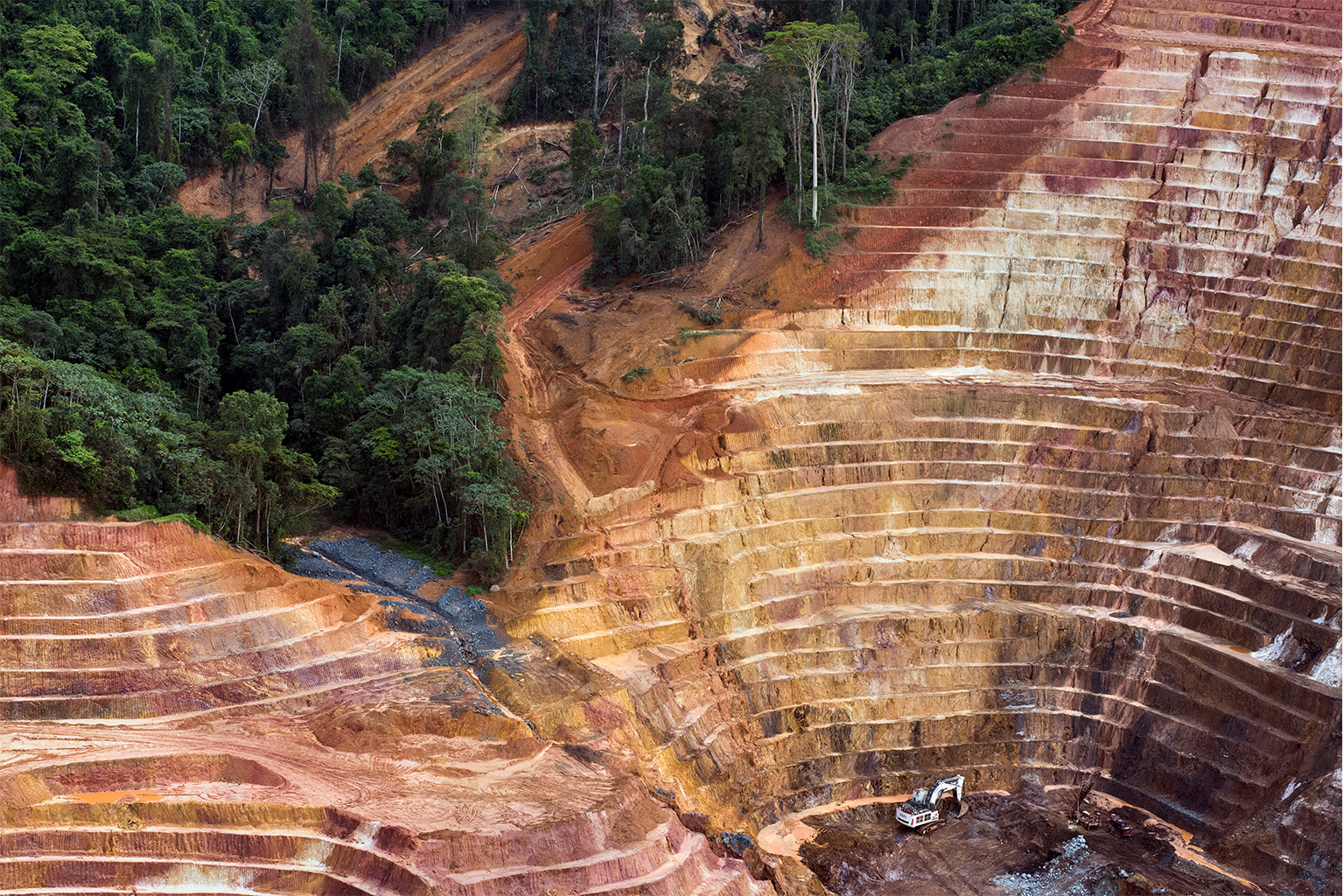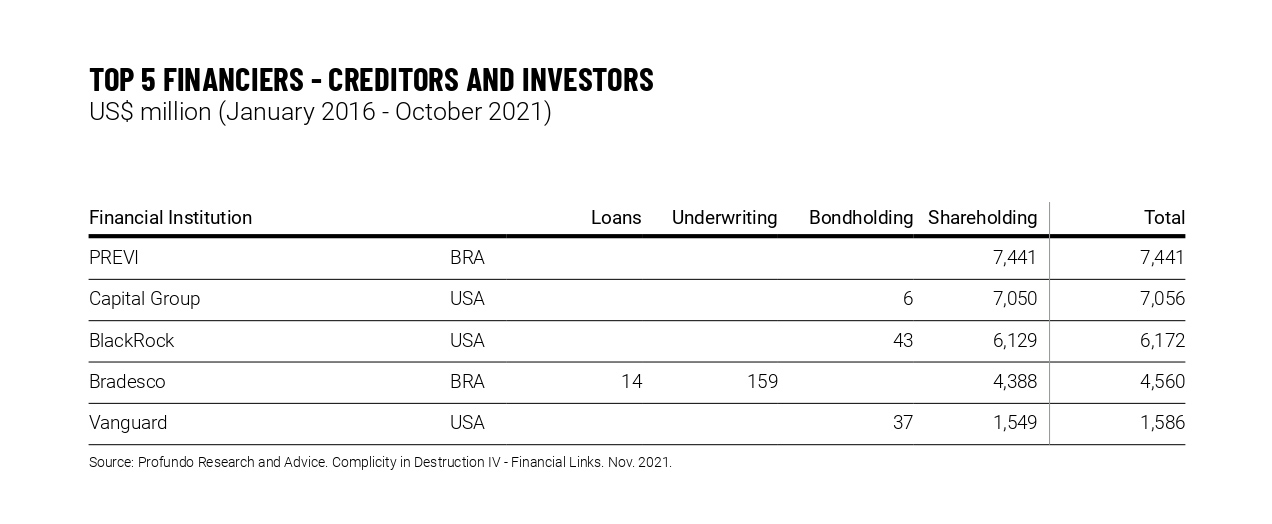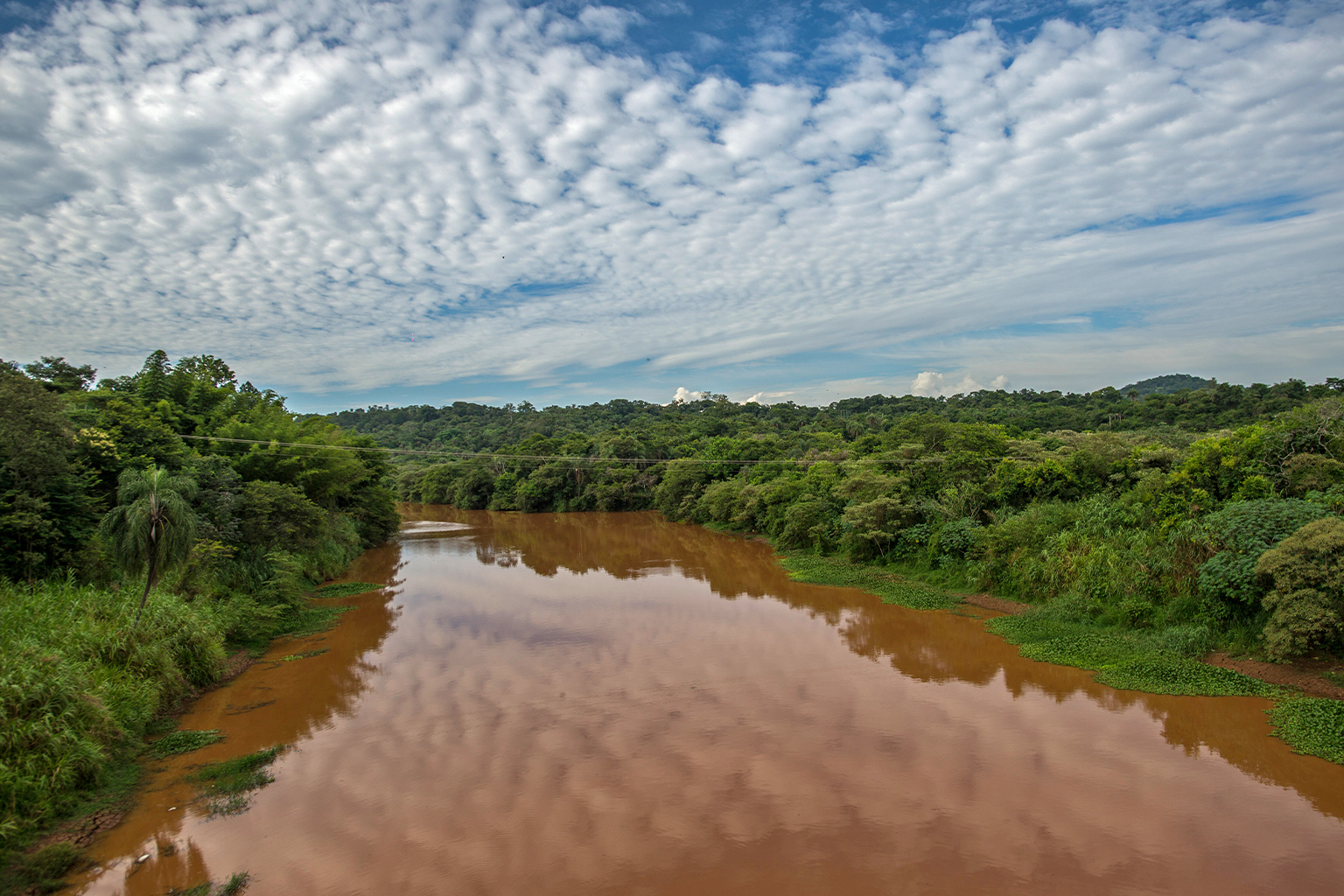- Major U.S. and Brazilian financial institutions continue to underwrite the destruction of the Amazon by financing mining companies pushing to operate in Indigenous territories, a new report says.
- The top financiers include BlackRock, Capital Group and Vanguard from the U.S., along with Brazilian pension fund PREVI, all of which have a stake in, have issued loans to or are otherwise financially invested in nine mining companies to the tune of $54.1 billion.
- The mining companies, which include Vale, Anglo American and Rio Tinto, have records of environmental destruction and human rights violations in Brazil and elsewhere, and several already operate close to Indigenous lands in Brazil, polluting rivers and harming the health of native communities.
- A bill currently before Brazil’s parliament could allow mining in Indigenous territories, which is currently prohibited under the country’s Constitution; the national mining authority, meanwhile, continues to register applications to mine in areas that overlap into Indigenous territories.
Major investment managers including BlackRock and Capital Group are among more than a dozen U.S. and Brazilian institutions heavily financing mining companies that are destroying Indigenous reserves and their inhabitants’ way of life in the Amazon.
That’s the finding from a report published Feb. 22 by the Articulation of the Indigenous Peoples of Brazil (Apib) — the country’s largest Indigenous organization — the NGO Amazon Watch, and the Amazônia Minada Project.
The 20 institutional investors plowed a combined $54.1 billion into nine mining conglomerates — including giants Vale, Anglo American, Belo Sun, AngloGold Ashanti and Rio Tinto — between 2016 and October 2021, according to the report.
Of that amount, $14.8 billion came from just three U.S. firms — BlackRock, Capital Group and Vanguard — with BlackRock alone alone pouring $6.2 billion into the mining companies. (BlackRock, Capital Group and Vanguard did not respond to Mongabay’s requests for comment.)
U.S.-based companies, the report says, “continue to be the leading financiers of mining-driven destruction, with holding the most significant shares and bonds, or offering the largest loans or underwriting, to the mining companies,” says the report.

Seven of the 20 institutional investors are Brazilian, led by PREVI, the employee pension fund of state-owned Banco do Brasil, followed by Bradesco bank. Mongabay has sought comment from PREVI and Bradesco but they didn’t immediately respond.
The mining companies, in turn, have submitted thousands of applications to Brazil’s National Mining Agency (ANM) to prospect in areas that overlap with fully protected Indigenous reserves and conservation units in the Amazon. Mining in reserves is prohibited under Brazil’s Constitution.
These companies were among 570 mining firms, international groups and industry associations that had 2,478 pending mining applications overlapping with 261 Indigenous territories in the ANM’s registry as of last November, the report says. The applications cover a combined 10.1 million hectares (25 million acres) of land, an area larger than South Korea.
“The amounts for these companies’ operations in Brazil [provide] a closer look into the interests that the financial institutions have in the country,” Rosana Miranda, Amazon Watch campaign advisor, told Mongabay by email. “It is a complex web, not only due to the intricacies involving [mining] subsidiary companies, but also to the opacity of the finance sector, which is usually used as a tool to avoid accountability around potentially destructive investments.”
The report also puts into context the growing financialization of the mining sector, given the rising price of several mineral commodities. This has driven a new boom, with the market value of the world’s 50 largest mining companies rising from more than $1 trillion during the first year of the COVID-19 pandemic to $1.4 trillion in July 2021, according to the report.
Miranda said many banks and asset managers justify these investments as “passive” ones that they have little leverage over. “This is quite a false notion, not only because they can (and should) have more control over their portfolio, but also because index funds have selection criteria that are created by fund managers — and if this criteria is not taking the future of the planet into account, then it needs to be reviewed,” she said.

“Indigenous areas have always been under a lot of pressure from the mining sector, but what is happening in the Bolsonaro government is a coordinated attack at the time of this pressure,” Marcio Astrini, executive secretary of the Observatório do Clima, or the Climate Observatory, a network of Brazilian civil society organizations advocating for climate action, said in a phone message.
Astrini noted that the PL 191 — a bill currently before Brazil’s National Congress aiming to mining activities in Indigenous territories — came right after conversations with mining companies.
“There are also investors now, as the report shows, putting money into this agenda of encroaching on Indigenous areas… Indigenous people in Brazil are experiencing one of the most delicate moments because there are several economic and political forces against these populations.”

Financiers affect the life of Indigenous people
In 2021, mining-related deforestation in the Brazilian Amazon increased by 62% compared to 2018, the year before Jair Bolsonaro took office as president. Despite mining activity in Indigenous territories being illegal, companies have pushed to be allowed to do so.
Among them is Vale, Brazil’s biggest miner and No. 5 in the world by revenue. Vale, together with Samarco and BHP, was responsible for the collapse of a tailings dam in the municipality of Brumadinho, Minas Gerais state, in 2019, that unleashed one of the largest mining disasters in the world. Although Vale announced last September that it would give up all its applications to mine in Indigenous territories , in the following month the company filed two new applications to prospect in areas adjacent to the Xikrin do Cateté Indigenous Territory, in Pará state, home to the Kayapó and Xikrin peoples. As of last November, Vale had 75 pending applications with the ANM that overlapped with Indigenous territories in the Amazon.
Vale has since 2011 been mining nickel close to the Xikrin do Cateté reserve. A study by the Federal University of Pará (UFPA) found excessive levels of heavy metal contamination in all samples taken from the reserve’s inhabitants, and warned that without measures to stem the pollution in the Cateté River from the Onça Puma mine, “we will be seeing the end of the Xikrin [people].”
Vale denies that its mine is responsible for the impacts identified by the UFPA researchers and the Indigenous community.
In a statement, Vale said it has no mineral rights overlapping Indigenous reserves in Brazil. In 2021, Vale relinquished all its mining rights on Indigenous Lands in Brazil. “In 2021, Vale relinquished all its mining rights on Indigenous Lands in Brazil, which includes all applications for exploration permits and mining concessions.”
The company added that it maintains requests for exploration permits and mining concessions in areas neighboring Indigenous lands “without any intersection with demarcated areas in the country, in strict compliance with the legislation in force in Brazil.”
Moreover, Vale said that the contamination claims of the Cateté River are “unfounded”, citing expert reports which attested that “there is no causality between the Onça Puma mining operation and the alleged contamination.”
In a statement, AngloGold Ashanti said that the company “does not operate and has no interest in operating in Indigenous lands.” According to the company, it requested mineral exploration requirements in several regions of the country in the 1990s but “three of these areas were later demarcated as Indigenous reserves, which led the company to give up on them.” However, AngloGold Ashanti said that as there was no process update in ANM’s system, it ratified its withdrawal request on June 21, 2021.
ANM did not respond to Mongabay’s requests for comment on why it continues to register applications for mining activity on land that overlaps into Indigenous reserves. A 2015 ordinance requires that mining operations be located at least 10 kilometers (6 miles) from Indigenous lands

“Companies like Vale have declared they would withdraw their ANM requests and, at the same time, have received huge funding in recent years,” Dinamam Tuxá, executive coordinator of APIB, told Mongabay by phone.
“Even if they move to areas surrounding the [Indigenous reserves], as permitted by Ordinance 60/2015, those activities contaminate our lands anyway, as heavy metals associated with mining end up reaching the riverbeds, which flow through the [reserves],” Dinamam Tuxá added.
Angohó Pataxó, a community leader and one of 222 Indigenous people whose lands and lives were affected by the Brumadinho dam disaster, told Mongabay that Vale does not recognize them as being directly impacted.
“They argue that we did not live very near the dam, but about 20 kilometers [12 mi] away,” she said in a phone interview. “The Paraopeba River, however, which runs through the village, was contaminated, as were our lands. We can no longer fish or hunt, we live on donations. And we can’t baptize our children who have been born since the disaster because the river is dead.”
Update (Feb. 23, 2022): This article was updated to include a statement from Vale about the findings of the report. Update (March 9, 2022): This article was updated to include a statement from AngloGold Ashanti about the findings of the report.
Banner image: Háyô Há-hã-hãe, leader of the Indigenous Pataxó Hã-hã-hãe Naô Xohã village, looks at the Paraopeba River, which was hit by a tide of toxic mud from the collapse of the Brumadinho tailings dam in January 2019. Image courtesy of Nilmar Lage/Greenpeace.
FEEDBACK: Use this form to send a message to the author of this post. If you want to post a public comment, you can do that at the bottom of the page.
